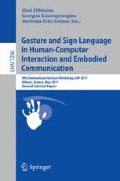Abstract
We present the results of an experimental study of Haptic Digital Audio Effects with and without force feedback. Participants experienced through a low cost Falcon haptic device two new real-time physical audio effect models we have developed under the CORDIS-ANIMA formalism. The results indicate that the haptic modality changed the user’s experience significantly.
Access this chapter
Tax calculation will be finalised at checkout
Purchases are for personal use only
Preview
Unable to display preview. Download preview PDF.
References
Berdahl, E., Kontogeorgakopoulos, A., Overholt, D.: HSP v2: Haptic Signal Processing with Extensions for Physical Modeling. In: 5th International Workshop on Haptic and Audio Interaction Design - HAID, Copenhagen, pp. 61–62 (2010)
Berdahl, E., Niemeyer, G., Smith III, J.: HSP: A Simple and Effective Open-Source Platform for Implementing Haptic Musical Instruments. In: 9th International Conference on New Interfaces for Musical Expression - NIME, Pittsburgh, PA, pp. 262–263 (2009)
Castagne, N., Cadoz, C.: GENESIS: A Friendly Musician-Oriented Environment for Mass-Interaction Physical Modeling. In: International Computer Music Conference - ICMC, Goteborg, Sweden, pp. 330–337 (2002)
MAX/MSP, http://www.cycling74.com
Puckette, M.S.: The Theory and Technique of Electronic Music. World Scientific Press, Singapore (2007)
Cadoz, C., Luciani, A., Florens, J.-L.: CORDIS-ANIMA: A modeling and Simulation System for Sound and Image Synthesis – The General Formalism. Computer Music Journal 17(1), 19–29 (1993)
Sensable Technologies Phantom, http://www.sensable.com
Novint Falcon, http://home.novint.com/
Vanacken, L., De Boeck, J., Coninx, K.: The Phantom versus the Falcon: Force Feedback Magnitude Effects on User”s Performance during Target Acquisition. In: Nordahl, R., Serafin, S., Fontana, F., Brewster, S. (eds.) HAID 2010. LNCS, vol. 6306, pp. 179–188. Springer, Heidelberg (2010)
Fitts, P.M.: The information capacity of the human motor system in controlling the amplitude of movement. Journal of Experimental Psychology 47(6), 381–391 (1954); reprinted in Journal of Experimental Psychology: General 121(3), 262–269 (1992)
ISO: Ergonomic requirements for office work with visual display terminals (vdts)-part 9: Req. for non-keyboard input devices. Technical Report 9241-9 (2000)
Kontogeorgakopoulos, A., Cadoz, C.: Amplitude Modification Algorithms using Physical Models. In: 124th Audio Engineering Society Convention, Amsterdam (2008)
Luciani, A., Florens, J.-L., Couroussé, D., Cadoz, C.: Ergotic Sounds A new way to improve Playability, Believability and Presence of Digital Musical Instruments. In: 4th Int. Conf. on Enactive Interfaces, pp. 373–376 (2007)
O’Modhrain. S.: Playing By Feel: Incorporating Haptic Feedback into Computer-Based Musical Instruments. PhD thesis, Stanford University, Stanford, CA, USA (2000)
Berdahl, E., Niemeyer, G., Smith III, J.: Using Haptics to Assist Performers in Making Gestures to a Musical Instrument. In: 9th International Conference on New Interfaces for Musical Expression - NIME, Pittsburgh PA, pp. 177–182 (2009)
Marshall, T., Wanderley, M.: Examining the Effects of Embedded Vibrotactile Feedback on the Feel of a Digital Musical Instrument. In: 11th International Conference on New Interfaces for Musical Expression - NIME, Oslo, Norway (2011)
Cadoz, C., Wanderley, M.: Gesture-Music. In: Wanderley M., Battier M. (eds.) Trends in Gestural Control of Music, IRCAM – Centre Pompidou, pp. 71–94 (2000)
Zoelzer, U. (ed.): Digital Audio Effects. John Wiley & Sons Ltd. (2002)
Author information
Authors and Affiliations
Editor information
Editors and Affiliations
Rights and permissions
Copyright information
© 2012 Springer-Verlag Berlin Heidelberg
About this paper
Cite this paper
Kontogeorgakopoulos, A., Kouroupetroglou, G. (2012). Low Cost Force-Feedback Interaction with Haptic Digital Audio Effects. In: Efthimiou, E., Kouroupetroglou, G., Fotinea, SE. (eds) Gesture and Sign Language in Human-Computer Interaction and Embodied Communication. GW 2011. Lecture Notes in Computer Science(), vol 7206. Springer, Berlin, Heidelberg. https://doi.org/10.1007/978-3-642-34182-3_5
Download citation
DOI: https://doi.org/10.1007/978-3-642-34182-3_5
Publisher Name: Springer, Berlin, Heidelberg
Print ISBN: 978-3-642-34181-6
Online ISBN: 978-3-642-34182-3
eBook Packages: Computer ScienceComputer Science (R0)

